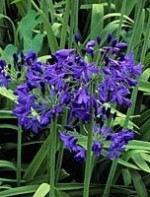 These rhizomatous perennials are hybrids that include in their parentage A. campanulatus, A. inapertus, A. praecox, and probably some others. They are members of the amaryllis family, Amaryllidaceae, that also includes daffodils, clivia, and onion. Plants grow 2-4′ tall and have fleshy roots and grey-green leathery strap-shaped leaves that may be deciduous or evergreen. Seventy to seventy-five white or light to dark blue, funnel-shaped flowers are carried in spherical umbels 3-8″ across on thick leafless stems 2-3′ high from mid to late summer. Plants bloom best when their roots have become crowded. The flowers are striking in the garden but the foliage is attractive even when the plant is not in bloom. Because the stems tend to lean towards the sun the plants should be located in a south facing border. Agapanthus is very popular with florists as the flowers last a long time in the vase. In cold climates plants can be raised in pots and brought in doors during the winter. The genus name, Agapanthus, comes from the Greek words agape meaning love, and anthos meaning flower.
These rhizomatous perennials are hybrids that include in their parentage A. campanulatus, A. inapertus, A. praecox, and probably some others. They are members of the amaryllis family, Amaryllidaceae, that also includes daffodils, clivia, and onion. Plants grow 2-4′ tall and have fleshy roots and grey-green leathery strap-shaped leaves that may be deciduous or evergreen. Seventy to seventy-five white or light to dark blue, funnel-shaped flowers are carried in spherical umbels 3-8″ across on thick leafless stems 2-3′ high from mid to late summer. Plants bloom best when their roots have become crowded. The flowers are striking in the garden but the foliage is attractive even when the plant is not in bloom. Because the stems tend to lean towards the sun the plants should be located in a south facing border. Agapanthus is very popular with florists as the flowers last a long time in the vase. In cold climates plants can be raised in pots and brought in doors during the winter. The genus name, Agapanthus, comes from the Greek words agape meaning love, and anthos meaning flower.
Type: Herbaceous perennial
Bloom: Umbels of white, and light to dark blue funnel-shaped flowers from mid to late summer
Size: 2-4′ H x 2′ W
Light: Full sun
Soil: Average, medium moist, well-drained; established plants somewhat drought tolerant
Hardiness: Zones 8-11
Care: Fertilize in spring; in cold climates bring plants indoors to the basement in fall. In spring water sparingly until growth begins; divide every 3-4 years.
Pests and Diseases: None of significance
Propagation: Division in spring, seed
Companion Plants: Daylilies, butterfly bush, coneflowers
Outstanding Selections:
‘Alice Gloucester; (creamy white flowers, 3′ tall, early blooming)
”Bressingham Blue’ (very deep blue flowers, 2.5-3.5′ tall)
‘Loch Hope’ (dark blue flowers, 3′ tall, late bloomer)
‘Luly’ (light blue flowers, 3′ tall)
‘Snowy Owl’ (white flowers)